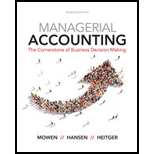
1.
Compute inherent risk.
1.
Answer to Problem 27BEB
Inherent risk is $400,000.
Explanation of Solution
Inherent Risk:
Inherent risk is a risk that prevails in a system before any control measure is adopted within an organization.
Computation of inherent risk:
Inherent risk can be computed by using the following formula:
Substitute $1,000,000 for impact and 40% for the probability of occurrence in the above formula.
Therefore, inherent risk is $400,000.
2.
Compute residual risk of each of the three alternatives.
2.
Answer to Problem 27BEB
Residual risk for alternative A, B, and C is $48,750, $105,000, and $400,000respectively.
Explanation of Solution
Residual risk can be computed by using the following formula:
Computation of residual risk for alternative A:
Substitute $325,000 for impact and 15% for the probability of occurrence in the above formula.
Computation of residual risk for alternative B:
Substitute $300,000 for impact and 35% for the probability of occurrence in the above formula.
Computation of residual risk for alternative C:
Substitute $1,000,000 for impact and 40% for the probability of occurrence in the above formula.
Therefore, residual risk for alternative A, B, and C is $48,750, $105,000, and $400,000 respectively.
3.
Compute benefit from each of the three alternatives.
3.
Answer to Problem 27BEB
Benefit from alternatives A, B, and C is $351,250, $295,000, and $0 respectively.
Explanation of Solution
Benefit from a risk response alternative can be computed by using the following formula:
Computation of response benefit from alternative A:
Substitute $400,000 for inherent risk and $48,750 for residual risk in the above formula.
Computation of response benefit from alternative B:
Substitute $400,000for inherent risk and $105,000 for residual risk in the above formula.
Computation of response benefit from alternative C:
Substitute $400,000for inherent risk and $400,000 for residual risk in the above formula.
Therefore, benefit from alternatives A, B, and C is $351,250, $295,000, and $0 respectively.
4.
Compute net benefit from each of the three alternatives.
4.
Answer to Problem 27BEB
Net benefit from alternatives A, B, and C is $150,000, $100,000, and $0 respectively.
Explanation of Solution
Net benefit from a risk response alternative can be computed by using the following formula:
Computation of net benefit from alternative A:
Substitute $351,250 for response benefit and $201,250 for response cost in the above formula:
Computation of net benefit from alternative B:
Substitute $295,000 for response benefit and $195,000 for response cost in the above formula:
Computation of net benefit from alternative C:
Substitute $0 for response benefit and $0 for response cost in the above formula:
Therefore, net benefit from alternatives A, B, and C is $150,000, $100,000, and $0 respectively.
5.
Identify the alternative which would be adopted by the company.
5.
Explanation of Solution
Alternative A would be chosen by the company since; net benefit is highest in case of alternative A.
Want to see more full solutions like this?
Chapter 13 Solutions
Bundle: Managerial Accounting: The Cornerstone of Business Decision-Making, 7th + CengageNOWv2, 1 term (6 months) Printed Access Card
- Explain the importance of the double-entry system in accounting. How does it help maintain the accuracy and integrity of financial records? Provide an example to support your explanation and describe what happens if only one side of the entry is recorded.arrow_forwardI am trying to find the accurate solution to this general accounting problem with the correct explanation.arrow_forwardI am looking for help with this general accounting question using proper accounting standards.arrow_forward
- provide answer pleasearrow_forwardI need help finding the accurate solution to this financial accounting problem with valid methods.arrow_forwardA firm sells 2,800 units of an item each year. The carrying cost per unit is $3.26 and the fixed costs per order are $74. What is the economic order quantity? (Please round units to the nearest whole number)arrow_forward
- A company sold goods for $12,000 on credit and later allowed a sales return of $2,000. Calculate the net sales to be reported in the income statement and explain the reasoning behind adjusting for returns. HELParrow_forwardConversion cost per unit equals $6. Total materials costs equal $60,000. Equivalent units for materials are 12,000. How much is the total manufacturing cost per unit?arrow_forwardThe contribution margin per unit was____.arrow_forward
 Managerial Accounting: The Cornerstone of Busines...AccountingISBN:9781337115773Author:Maryanne M. Mowen, Don R. Hansen, Dan L. HeitgerPublisher:Cengage Learning
Managerial Accounting: The Cornerstone of Busines...AccountingISBN:9781337115773Author:Maryanne M. Mowen, Don R. Hansen, Dan L. HeitgerPublisher:Cengage Learning
